Improved Light Hydrocarbon, Furans, and BTEX Production from the Catalytic Assisted Pyrolysis of Agave salmiana Bagasse over Silica Mesoporous Catalysts
Abstract
1. Introduction
2. Results
2.1. Catalyst Characterization
2.2. Biomass Characterization
2.3. Thermal Decomposition of ASB by Thermogravimetric Analysis (TGA)
2.4. Non-Catalytic Pyrolysis of Agave Salmiana Bagasse (ASB)
2.5. Use of Catalysts in Bio-Oil Upgrading
2.6. Catalytic Pyrolysis of Agave salmiana Bagasse with Aerosil
2.7. Catalytic Pyrolysis of Agave salmiana Bagasse with MCM-41
3. Materials and Methods
3.1. Biomass Preparation and Characterization
3.2. Catalyst Synthesis
3.3. Scanning Electron Microscopy (SEM), and High Resolution Transmition Electron Microscopy (HR-TEM)
3.4. Small Angle X-ray Scattering (SAXS), and Large X-ray Diffraction (XRD)
3.5. Nitrogen Physisorption
3.6. Fourier-Transform Infrared Spectroscopy
3.7. Conventional, and Catalytic Pyrolysis
4. Conclusions
Author Contributions
Funding
Data Availability Statement
Acknowledgments
Conflicts of Interest
References
- Alonso, D.M.; Bond, J.Q.; Dumesic, J.A. Catalytic conversion of biomass to biofuels. Green Chem. 2010, 12, 1493–1513. [Google Scholar] [CrossRef]
- Huber, G.W.; Iborra, S.; Corma, A. Synthesis of transportation fuels from biomass: Chemistry, catalysts, and engineering. Chem. Rev. 2006, 106, 4044–4098. [Google Scholar] [CrossRef] [PubMed]
- Zhang, Y.H.P. Reviving the carbohydrate economy via multi-product lignocellulose biorefineries. J. Ind. Microbiol. Biotechnol. 2008, 35, 367–375. [Google Scholar] [CrossRef]
- Cushman, J.C.; Davis, S.C.; Yang, X.; Borland, A.M. Development and use of bioenergy feedstocks for semi-arid and arid lands. J. Exp. Bot. 2015, 66, 4177–4193. [Google Scholar] [CrossRef] [PubMed]
- Nava-Cruza, N.Y.; Medina-Moralesa, M.A.; Martineza, J.L.; Rodrigueza, R.; Aguilara, C.N. Agave biotechnology: An overview. Crit. Rev. Biotechnol. 2015, 35, 546–559. [Google Scholar] [CrossRef] [PubMed]
- Davis, S.C.; Dohleman, F.G.; Long, S.P. The global potential for Agave as a biofuel feedstock. GCB Bioenergy 2011, 3, 68–78. [Google Scholar] [CrossRef]
- Hoz-Zavala, M.E.E.; Nava-Diguero, P. Situación del Agave y sus residuos en Tamaulipas. Rev. Energías Renov. 2017, 1, 19–31. [Google Scholar]
- Chávez-Guerrero, L.; Hinojosa, M. Bagasse from the mezcal industry as an alternative renewable energy produced in arid lands. Fuel 2010, 89, 4049–4052. [Google Scholar] [CrossRef]
- Consejo Regulador del Tequila Informe Estadístico del Consejo Regulador del Tequila. 2021. Available online: https://www.crt.org.mx/EstadisticasCRTweb/. (accessed on 11 March 2022).
- Consejo Regulador del Mezcal Información Estadístico 2020. Available online: http://www.crm.org.mx/informes.php (accessed on 30 March 2021).
- Hoz-Zavala, M.E.E.; Nava-Diguero, P. Los residuos de agave como factor de corrosión del suelo donde se vierte. Rev. Desarro. Tecnol. 2017, 1, 11–24. [Google Scholar]
- Jiménez Muñoz, E.; Prieto García, F.; Prieto Méndez, J.; Acevedo Sandoval, O.A.; Rodríguez Laguna, R.; Otazo Sánchez, E.M. Utilization of Waste Agaves: Potential for Obtaining Cellulose Pulp. Cienc. Tec. Vitivinic. 2014, 29, 223–254. [Google Scholar]
- Pinos-Rodríguez, J.M.; Aguirre-Rivera, J.R.; García-López, J.C.; Rivera-Miranda, M.T.; González-Muñoz, S.; López-Aguirre, S.; Chávez-Villalobos, D. Use of “maguey” (Agave salmiana otto ex. salm-dick) as forage for ewes. J. Appl. Anim. Res. 2006, 30, 101–107. [Google Scholar] [CrossRef]
- Parascanu, M.M.; Sandoval-Salas, F.; Soreanu, G.; Valverde, J.L.; Sanchez-Silva, L. Valorization of Mexican biomasses through pyrolysis, combustion and gasification processes. Renew. Sustain. Energy Rev. 2017, 71, 509–522. [Google Scholar] [CrossRef]
- Saucedo-Luna, J.; Castro-Montoya, A.J.; Rico, J.L.; Campos-García, J. Optimización de hidrólisis ácida de bagaso de Agave tequilana Weber. Rev. Mex. Ing. Qum. 2010, 9, 91–97. [Google Scholar]
- Liñán-Montes, A.; De La Parra-Arciniega, S.M.; Garza-González, M.T.; García-Reyes, R.B.; Soto-Regalado, E.; Cerino-Córdova, F.J. Characterization and thermal analysis of agave bagasse and malt spent grain. J. Therm. Anal. Calorim. 2014, 115, 751–758. [Google Scholar] [CrossRef]
- Bernardo, G.R.R.; Rene, R.M.J. Contribution of agro-waste material main components (hemicelluloses, cellulose, and lignin) to the removal of chromium (III) from aqueous solution. J. Chem. Technol. Biotechnol. 2009, 84, 1533–1538. [Google Scholar] [CrossRef]
- Akhtar, J.; Saidina Amin, N. A review on operating parameters for optimum liquid oil yield in biomass pyrolysis. Renew. Sustain. Energy Rev. 2012, 16, 5101–5109. [Google Scholar] [CrossRef]
- Torres, C.; Rostom, S.; de Lasa, H. An Eco-Friendly Fluidizable FexOy/CaO-γ-Al2O3 Catalyst for Tar Cracking during Biomass Gasification Cindy. Catalysts 2020, 10, 806. [Google Scholar] [CrossRef]
- Li, P.; Li, D.; Yang, H.; Wang, X.; Chen, H. Effects of Fe-, Zr-, and Co-Modified Zeolites and Pretreatments on Catalytic Upgrading of Biomass Fast Pyrolysis Vapors. Energy Fuels 2016, 30, 3004–3013. [Google Scholar] [CrossRef]
- Kelkar, S.; Saffron, C.M.; Andreassi, K.; Li, Z.; Murkute, A.; Miller, D.J.; Pinnavaia, T.J.; Kriegel, R.M. A survey of catalysts for aromatics from fast pyrolysis of biomass. Appl. Catal. B Environ. 2015, 174–175, 85–95. [Google Scholar] [CrossRef]
- Xue, Z.; Zhong, Z.; Zhang, B. Microwave-assisted catalytic fast pyrolysis of biomass for hydrocarbon production with physically mixed MCM-41 and ZSM-5. Catalysts 2020, 10, 685. [Google Scholar] [CrossRef]
- Ratnasari, D.K.; Bijl, A.; Yang, W.; Jönsson, P.G. Effect of H-ZSM-5 and Al-MCM-41 proportions in catalyst mixtures on the composition of bio-oil in ex-situ catalytic pyrolysis of lignocellulose biomass. Catalysts 2020, 10, 868. [Google Scholar] [CrossRef]
- De, S.; Dutta, S.; Saha, B. Critical design of heterogeneous catalysts for biomass valorization: Current thrust and emerging prospects. Catal. Sci. Technol. 2016, 6, 7364–7385. [Google Scholar] [CrossRef]
- Diez, A.S.; Alvarez, M.; Volpe, M.A. Metal-modified mesoporous silicate (MCM-41) material: Preparation, characterization and applications as an adsorbent. J. Braz. Chem. Soc. 2015, 26, 1542–1550. [Google Scholar] [CrossRef]
- Taguchi, A.; Schüth, F. Ordered mesoporous materials in catalysis. Microporous Mesoporous Mater. 2005, 77, 1–45. [Google Scholar] [CrossRef]
- Meziani, M.J.; Zajac, J.; Jones, D.J.; Partyka, S.; Rozière, J.; Auroux, A. Number and strength of surface acidic sites on porous aluminosilicates of the MCM-41 type inferred from a combined microcalorimetric and adsorption study. Langmuir 2000, 16, 2262–2268. [Google Scholar] [CrossRef]
- Martín-Aranda, R.M.; Čejka, J. Recent advances in catalysis over mesoporous molecular sieves. Top. Catal. 2010, 53, 141–153. [Google Scholar] [CrossRef]
- Carrott, M.M.L.R.; Este, A.J.; Carrott, P.J.M.; Unger, K.K. Evaluation of the Stability of Pure Silica MCM-41 toward Water Vapor. Langmuir 1999, 15, 8895–8901. [Google Scholar] [CrossRef]
- Hu, S.; Liu, D.; Li, L.; Borgna, A.; Yang, Y. A non-sodium synthesis of highly ordered V-MCM-41 and its catalytic application in isomerization. Catal. Lett. 2009, 129, 478–485. [Google Scholar] [CrossRef]
- Wang, X.; Zhou, G.; Chen, Z.; Jiang, W.; Zhou, H. In-situ synthesis and characterization of V-MCM-41 for oxidative dehydrogenation of n-butane. Microporous Mesoporous Mater. 2016, 223, 261–267. [Google Scholar] [CrossRef]
- Beck, J.S.; Vartuli, J.C.; Roth, W.J.; Leonowicz, M.E.; Kresge, C.T.; Schmitt, K.D.; Chu, C.T.W.; Olson, D.H.; Sheppard, E.W.; McCullen, S.B.; et al. A New Family of Mesoporous Molecular Sieves Prepared with Liquid Crystal Templates. J. Am. Chem. Soc. 1992, 114, 10834–10843. [Google Scholar] [CrossRef]
- Thommes, M.; Kaneko, K.; Neimark, A.V.; Olivier, J.P.; Rodriguez-Reinoso, F.; Rouquerol, J.; Sing, K.S.W. Physisorption of gases, with special reference to the evaluation of surface area and pore size distribution (IUPAC Technical Report). Pure Appl. Chem. 2015, 87, 1051–1069. [Google Scholar] [CrossRef]
- Kresge, C.T.; Leonowicz, M.E.; Roth, W.J.; Vartuli, J.C.; Beck, J.S. Ordered mesoporous molecular sieves synthesized by a liquid-crystal template mechanism. Nature 1992, 359, 710–712. [Google Scholar] [CrossRef]
- Amama, P.B.; Lim, S.; Ciuparu, D.; Yang, Y.; Pfefferle, L.; Haller, G.L. Synthesis, characterization, and stability of Fe-MCM-41 for production of carbon nanotubes by acetylene pyrolysis. J. Phys. Chem. B 2005, 109, 2645–2656. [Google Scholar] [CrossRef] [PubMed]
- Froba, M.; Thommes, M.; Ko, R. Sorption and pore condensation behavior of pure fluids in mesoporous MCM-48 silica, MCM-41 silica, SBA-15 silica and controlled-pore glass at temperatures above and below the bulk triple point. Appl. Surf. Sci. 2002, 196, 239–249. [Google Scholar]
- Barrett, E.P.; Joyner, L.G.; Halenda, P.P. The Determination of Pore Volume and Area Distributions in Porous Substances. I. Computations from Nitrogen Isotherms. J. Am. Chem. Soc. 1951, 73, 373–380. [Google Scholar] [CrossRef]
- Kruk, M.; Jaroniec, M.; Sayari, A. Application of Large Pore MCM-41 Molecular Sieves To Improve Pore Size Analysis Using Nitrogen Adsorption Measurements. Langmuir 2002, 13, 6267–6273. [Google Scholar] [CrossRef]
- Chakraborty, B.; Viswanathan, B. Surface acidity of MCM-41 by in situ IR studies of pyridine adsorption. Catal. Today 1999, 49, 253–260. [Google Scholar] [CrossRef]
- Yang, H.; Yan, R.; Chen, H.; Lee, D.H.; Zheng, C. Characteristics of hemicellulose, cellulose and lignin pyrolysis. Fuel 2007, 86, 1781–1788. [Google Scholar] [CrossRef]
- Zhou, X.; Li, W.; Mabon, R.; Broadbelt, L.J. A Critical Review on Hemicellulose Pyrolysis. Energy Technol. 2017, 5, 216. [Google Scholar] [CrossRef]
- Shen, D.K.; Gu, S. The mechanism for thermal decomposition of cellulose and its main products. Bioresour. Technol. 2009, 100, 6496–6504. [Google Scholar] [CrossRef] [PubMed]
- Liu, C.; Hu, J.; Zhang, H.; Xiao, R. Thermal conversion of lignin to phenols: Relevance between chemical structure and pyrolysis behaviors. Fuel 2016, 182, 864–870. [Google Scholar] [CrossRef]
- Monteil-Rivera, F.; Phuong, M.; Ye, M.; Halasz, A.; Hawari, J. Isolation and characterization of herbaceous lignins for applications in biomaterials. Ind. Crops Prod. 2013, 41, 356–364. [Google Scholar] [CrossRef]
- Sanchez-Silva, L.; López-González, D.; Villaseñor, J.; Sánchez, P.; Valverde, J.L. Thermogravimetric-mass spectrometric analysis of lignocellulosic and marine biomass pyrolysis. Bioresour. Technol. 2012, 109, 163–172. [Google Scholar] [CrossRef]
- Shen, D.K.; Gu, S.; Luo, K.H.; Wang, S.R.; Fang, M.X. The pyrolytic degradation of wood-derived lignin from pulping process. Bioresour. Technol. 2010, 101, 6136–6146. [Google Scholar] [CrossRef]
- Wang, S.; Wang, K.; Liu, Q.; Gu, Y.; Luo, Z.; Cen, K.; Fransson, T. Comparison of the pyrolysis behavior of lignins from different tree species. Biotechnol. Adv. 2009, 27, 562–567. [Google Scholar] [CrossRef] [PubMed]
- Shen, D.; Jin, W.; Hu, J.; Xiao, R.; Luo, K. An overview on fast pyrolysis of the main constituents in lignocellulosic biomass to valued-added chemicals: Structures, pathways and interactions. Renew. Sustain. Energy Rev. 2015, 51, 761–774. [Google Scholar] [CrossRef]
- Stefanidis, S.D.; Kalogiannis, K.G.; Iliopoulou, E.F.; Michailof, C.M.; Pilavachi, P.A.; Lappas, A.A. A study of lignocellulosic biomass pyrolysis via the pyrolysis of cellulose, hemicellulose and lignin. J. Anal. Appl. Pyrolysis 2014, 105, 143–150. [Google Scholar] [CrossRef]
- Wu, S.; Shen, D.; Hu, J.; Zhang, H.; Xiao, R. Cellulose-lignin interactions during fast pyrolysis with different temperatures and mixing methods. Biomass Bioenergy 2016, 90, 209–217. [Google Scholar] [CrossRef]
- Collard, F.X.; Blin, J. A review on pyrolysis of biomass constituents: Mechanisms and composition of the products obtained from the conversion of cellulose, hemicelluloses and lignin. Renew. Sustain. Energy Rev. 2014, 38, 594–608. [Google Scholar] [CrossRef]
- Acree, W.E.; Chickos, J.J.S. Mass pectra. In NIST Chemistry WebBook Standar Reference Database Number 69; Linstrom, P.J., Mallard, W.G., Eds.; National Institute of Standars and Technology: Gaithersburg, MD, USA, 2005. [Google Scholar]
- Werner, K.; Pommer, L.; Broström, M. Thermal decomposition of hemicelluloses. J. Anal. Appl. Pyrolysis 2014, 110, 130–137. [Google Scholar] [CrossRef]
- Wang, Z.; McDonald, A.G.; Westerhof, R.J.M.; Kersten, S.R.A.; Cuba-Torres, C.M.; Ha, S.; Pecha, B.; Garcia-Perez, M. Effect of cellulose crystallinity on the formation of a liquid intermediate and on product distribution during pyrolysis. J. Anal. Appl. Pyrolysis 2013, 100, 56–66. [Google Scholar] [CrossRef]
- Kim, U.; Hyun, S.; Wada, M. Thermal decomposition of native cellulose: In fluence on crystallite size. Polym. Degrad. Stab. 2010, 95, 778–781. [Google Scholar] [CrossRef]
- Degroot, W.F.; Pan, W.P.; Rahman, M.D.; Richards, G.N. First chemical events in pyrolysis of wood. J. Anal. Appl. Pyrolysis 1988, 13, 221–231. [Google Scholar] [CrossRef]
- Yogalakshmi, K.N.; Poornima Devi, T.; Sivashanmugam, S.; Kavitha, S.; Yukesh Kannah, R.; Varjani, S.; AdishKumar, S.; Kumar, G.; Rajesh Banu, J. Lignocellulosic biomass-based pyrolysis: A comprehensive review. Chemosphere 2022, 286, 131824. [Google Scholar] [CrossRef]
- Boot, M.; Frijters, P.; Luijten, C.; Somers, B.; Baert, R.; Donkerbroek, A.; Klein-Douwel, R.J.H.; Dam, N. Cyclic oxygenates: A new class of second-generation biofuels for diesel engines? Energy Fuels 2009, 23, 1808–1817. [Google Scholar] [CrossRef]
- Nimmanwudipong, T.; Runnebaum, R.C.; Block, D.E.; Gates, B.C. Catalytic reactions of guaiacol: Reaction network and evidence of oxygen removal in reactions with hydrogen. Catal. Lett. 2011, 141, 779–783. [Google Scholar] [CrossRef]
- Azeez, A.M.; Meier, D.; Odermatt, J. Temperature dependence of fast pyrolysis volatile products from European and African biomasses. J. Anal. Appl. Pyrolysis 2011, 90, 81–92. [Google Scholar] [CrossRef]
- Papari, S.; Hawboldt, K. A review on condensing system for biomass pyrolysis process. Fuel Process. Technol. 2018, 180, 1–13. [Google Scholar] [CrossRef]
- Barnette, A.L.; Asay, D.B.; Janik, M.J.; Kim, S.H. Adsorption isotherm and orientation of alcohols on hydrophilic SiO2 under ambient conditions. J. Phys. Chem. C 2009, 113, 10632–10641. [Google Scholar] [CrossRef]
- Güllü, D.; Demirbaş, A. Biomass to methanol via pyrolysis process. Energy Convers. Manag. 2001, 42, 1349–1356. [Google Scholar] [CrossRef]
- Shafizadeh, F. Introduction to pyrolysis of biomass. J. Anal. Appl. Pyrolysis 1982, 3, 283–305. [Google Scholar] [CrossRef]
- Samolada, M.C.; Papafotica, A.; Vasalos, I.A. Catalyst Evaluation for Catalytic Biomass Pyrolysis. Energy Fuels 2000, 14, 1161–1167. [Google Scholar] [CrossRef]
- Vispute, T.P.; Zhang, H.; Sanna, A.; Xiao, R.; Huber, G.W. Renewable chemical commodity feedstocks from integrated catalytic processing of pyrolysis oils. Science 2010, 330, 1222–1227. [Google Scholar] [CrossRef] [PubMed]
- Evans, R.J.; Milne, T.A. An American Chemical Society Journal. Energy Fuels 1987, 1, 123–137. [Google Scholar] [CrossRef]
- Conner, W.C.; Weist, E.L.; Ito, T.; Fraissard, J. Characterization of the porous structure of agglomerated microspheres by129Xe NMR spectroscopy. J. Phys. Chem. 1989, 93, 4138–4142. [Google Scholar] [CrossRef]
- Niu, X.; Song, Y.; Xie, S.; Liu, S.; Wang, Q.; Xu, L. Synthesis and catalytic reactivity of MCM-22/ZSM-35 composites for olefin aromatization. Catal. Lett. 2005, 103, 211–218. [Google Scholar] [CrossRef]
- Kumar, N.; Lindfors, L.E. Synthesis, characterization and application of H-MCM-22, Ga-MCM-22 and Zn-MCM-22 zeolite catalysts in the aromatization of n-butane. Appl. Catal. A Gen. 1996, 147, 175–187. [Google Scholar] [CrossRef]
- Corma, A.; Martínez-Soria, V.; Schnoeveld, E. Alkylation of benzene with short-chain olefins over MCM-22 zeolite: Catalytic behaviour and kinetic mechanism. J. Catal. 2000, 192, 163–173. [Google Scholar] [CrossRef]
- Sluiter, A.; Hames, B.; Ruiz, R.; Scarlata, C.; Sluiter, J.; Templeton, D. Determination of Ash in Biomass; NREL/TP-510-42622; NREL, Laboratory Analytical Procedure (LAP): Golden, CO, USA, 2008. [Google Scholar]
- Sluiter, A.; Hames, B.; Hyman, D.; Payne, C.; Ruiz, R.; Scarlata, C.; Sluiter, J.; Templeton, D.; Wolfe, J. Determination of Total Solids in Biomass and Total Dissolved Solids in Liquid Process Samples; NREL/TP-510-42621; NREL, Laboratory Analytical Procedure (LAP): Golden, CO, USA, 2008. [Google Scholar]
- Sluiter, A.; Hames, B.; Ruiz, R.O.; Scarlata, C.; Sluiter, J.; Templeton, D.; Energy, D. Determination of Structural Carbohydrates and Lignin in Biomass; NREL/TP-510-42618; NREL, Laboratory Analytical Procedure (LAP): Golden, CO, USA, 2008. [Google Scholar]
- Sluiter, A.; Ruiz, R.; Scarlata, C.; Sluiter, J.; Templeton, D. Determination of Extractives in Biomass; NREL/TP-510-42619; NREL, Laboratory Analytical Procedure (LAP): Golden, CO, USA, 2008. [Google Scholar]
- Handy, B.E.; Sharma, S.B.; Spiewak, B.E.; Dumesic, J.A. A Tian-Calvet heat-flux microcalorimeter for measurement of differential heats of adsorption. Meas. Sci. Technol. 1993, 4, 1350–1356. [Google Scholar] [CrossRef]
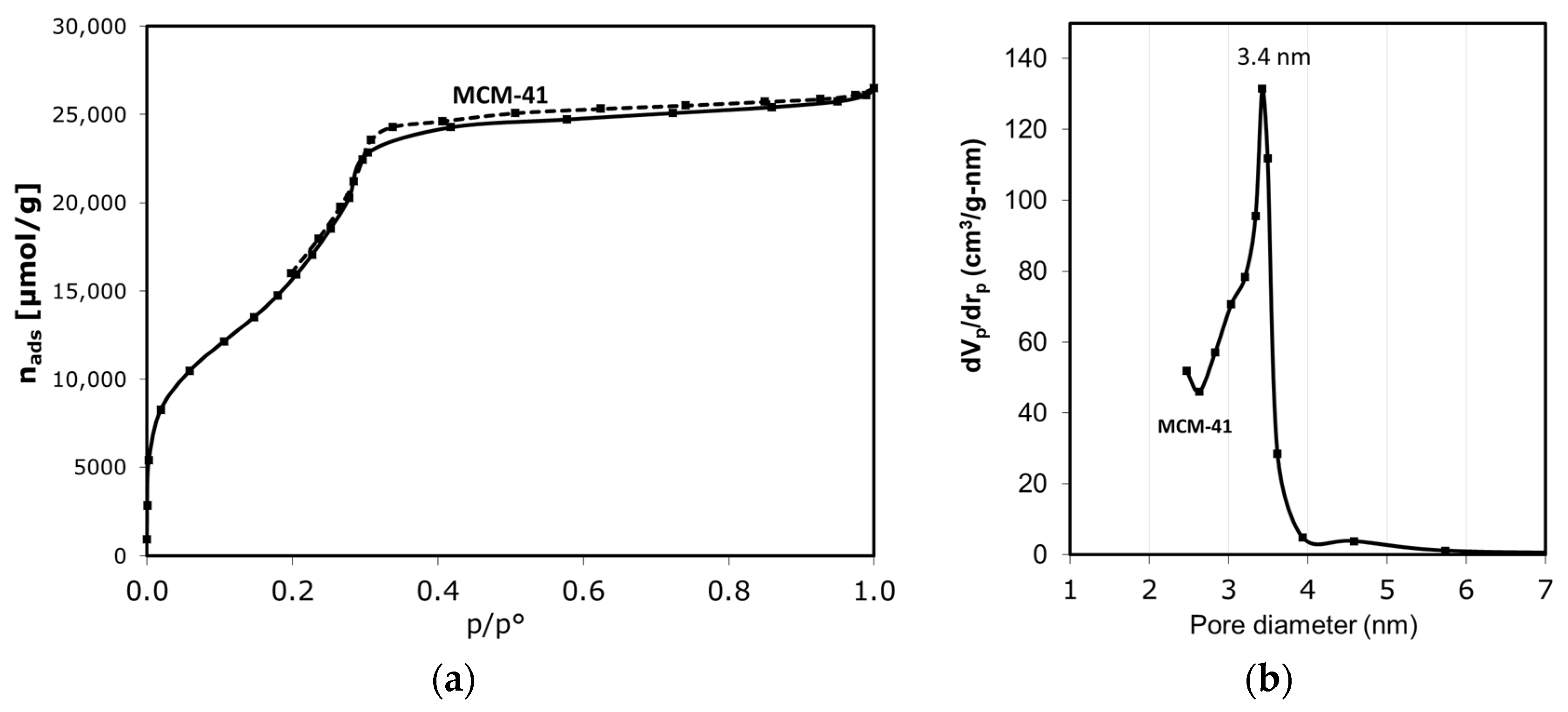



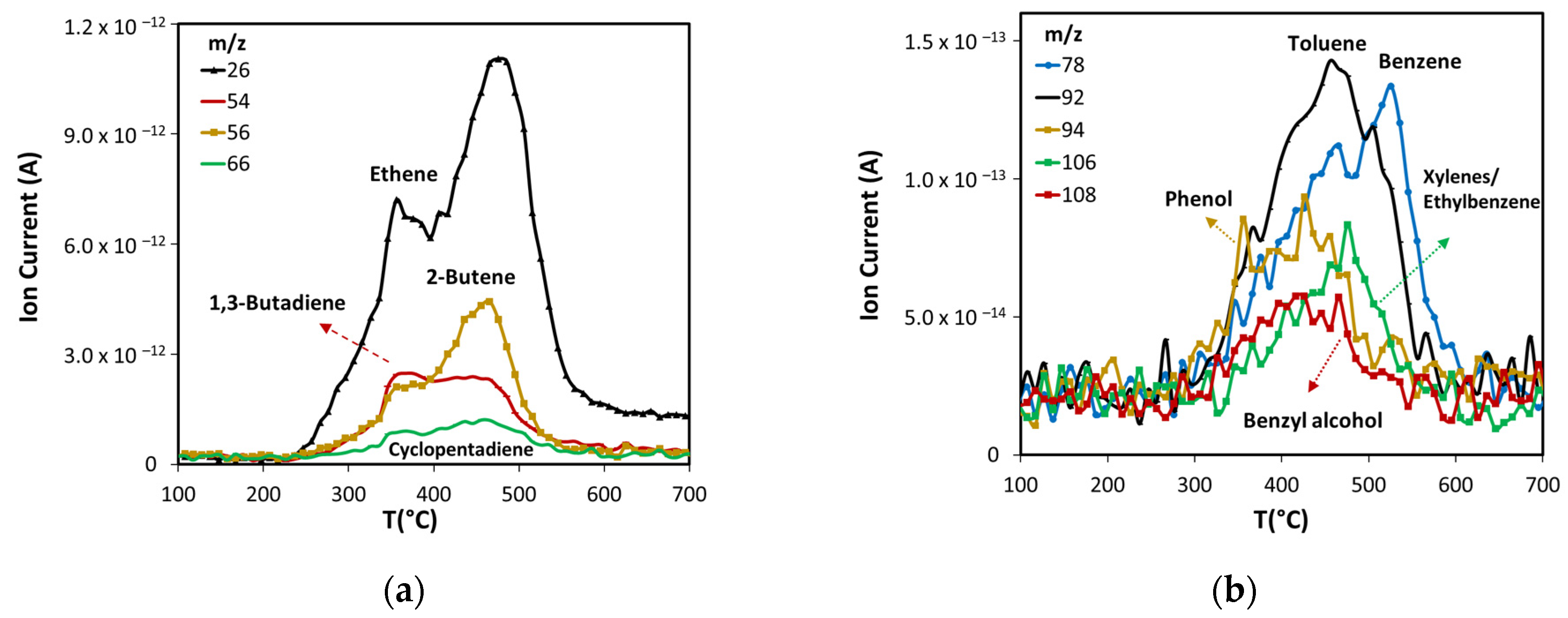
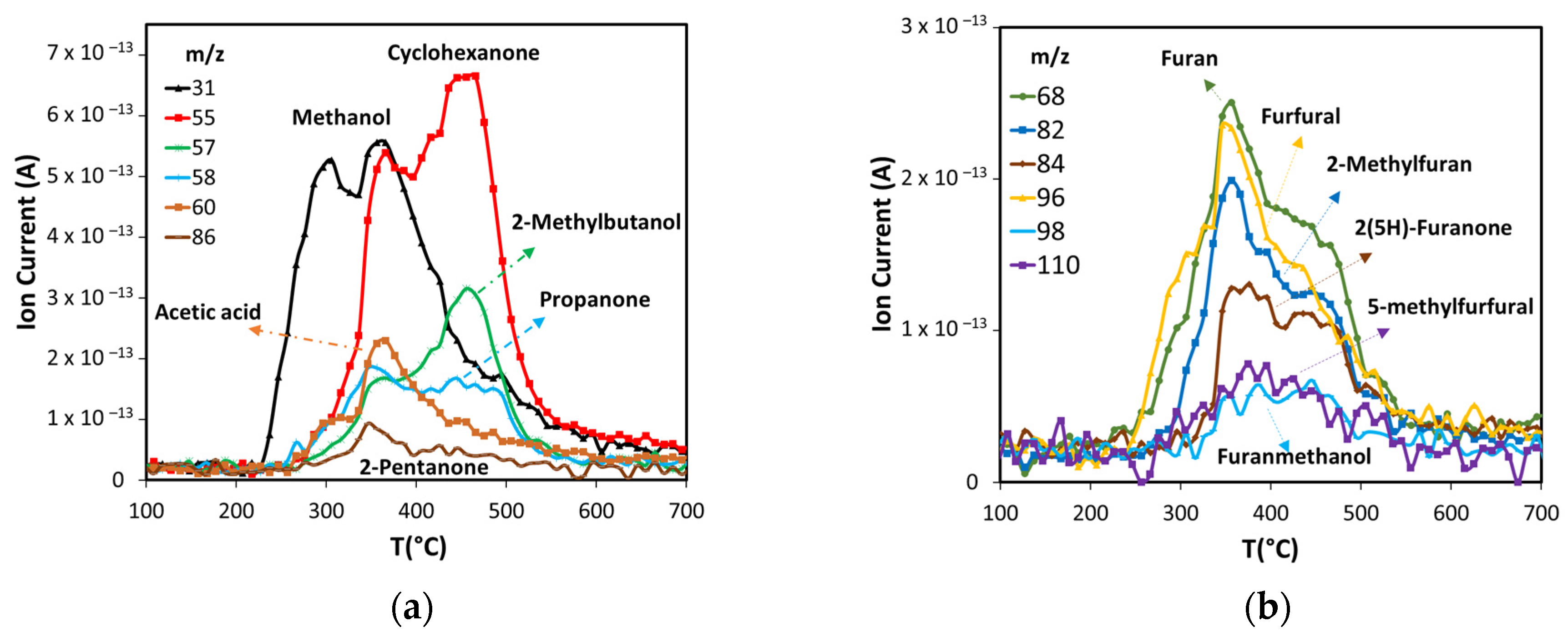
 ASB,
ASB,  Aerosil 380,
Aerosil 380,  MCM-41).
MCM-41).
 ASB,
ASB,  Aerosil 380,
Aerosil 380,  MCM-41).
MCM-41).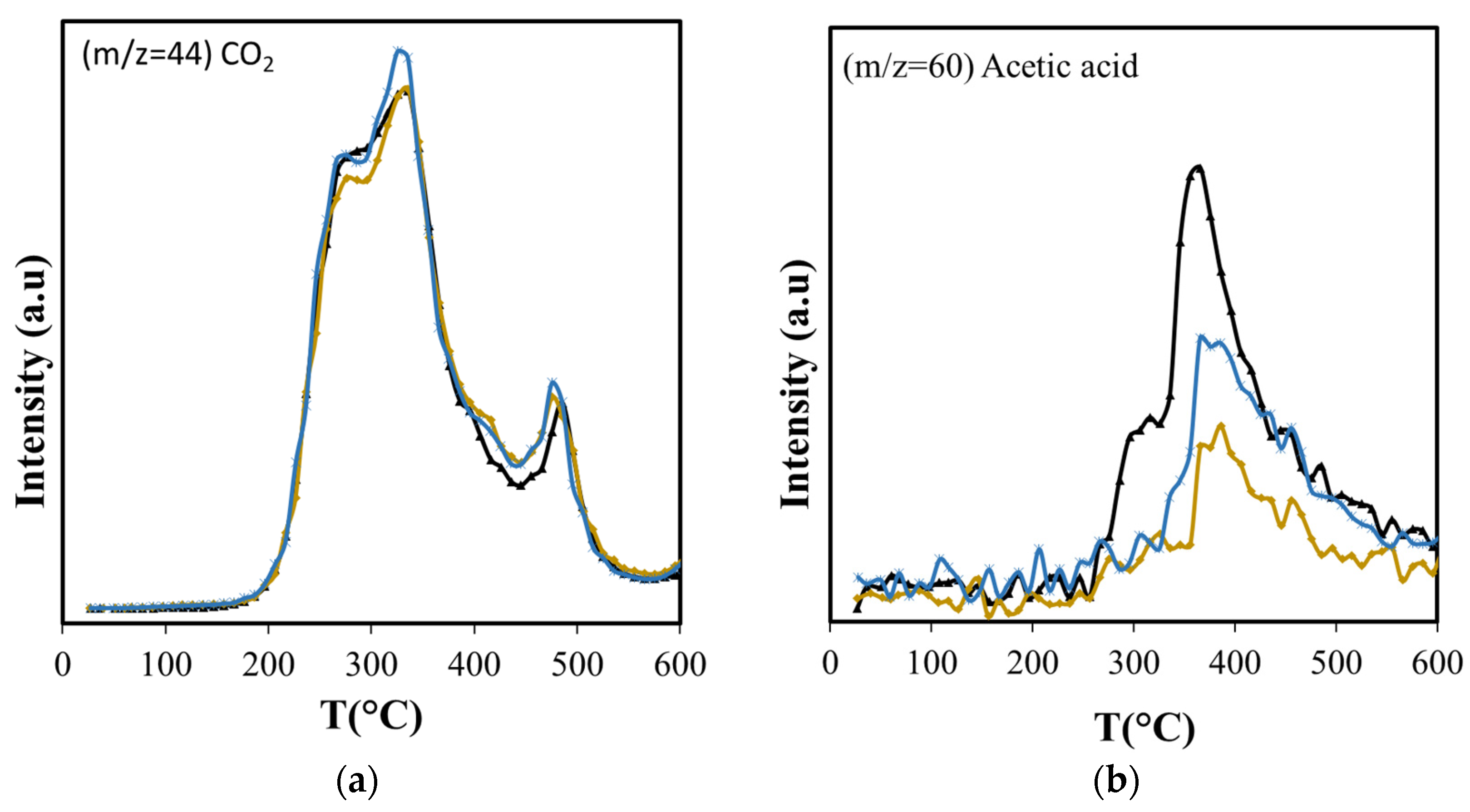
 ASB,
ASB,  Aerosil 380,
Aerosil 380,  MCM-41).
MCM-41).
 ASB,
ASB,  Aerosil 380,
Aerosil 380,  MCM-41).
MCM-41).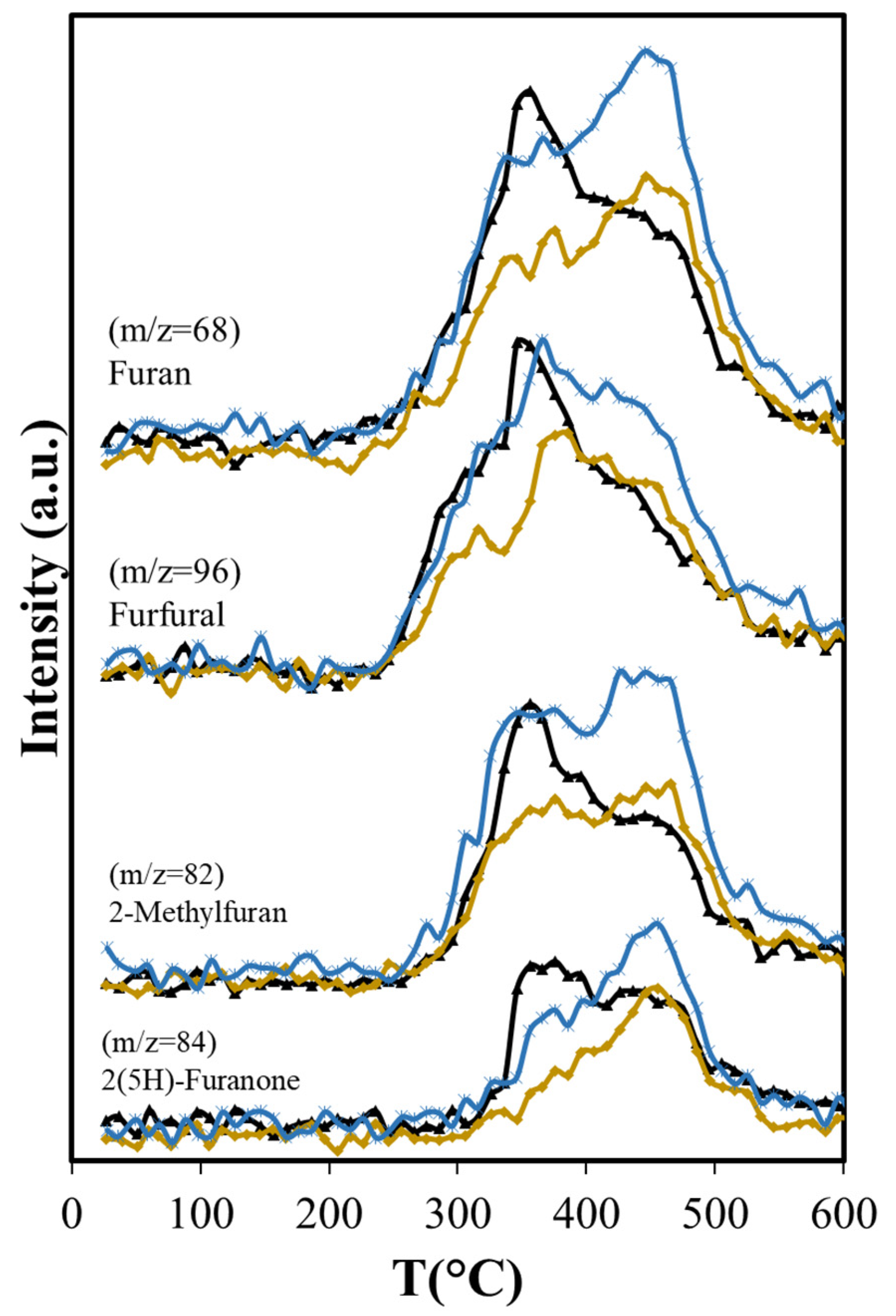
 ASB,
ASB,  Aerosil 380,
Aerosil 380,  MCM-41).
MCM-41).
 ASB,
ASB,  Aerosil 380,
Aerosil 380,  MCM-41).
MCM-41).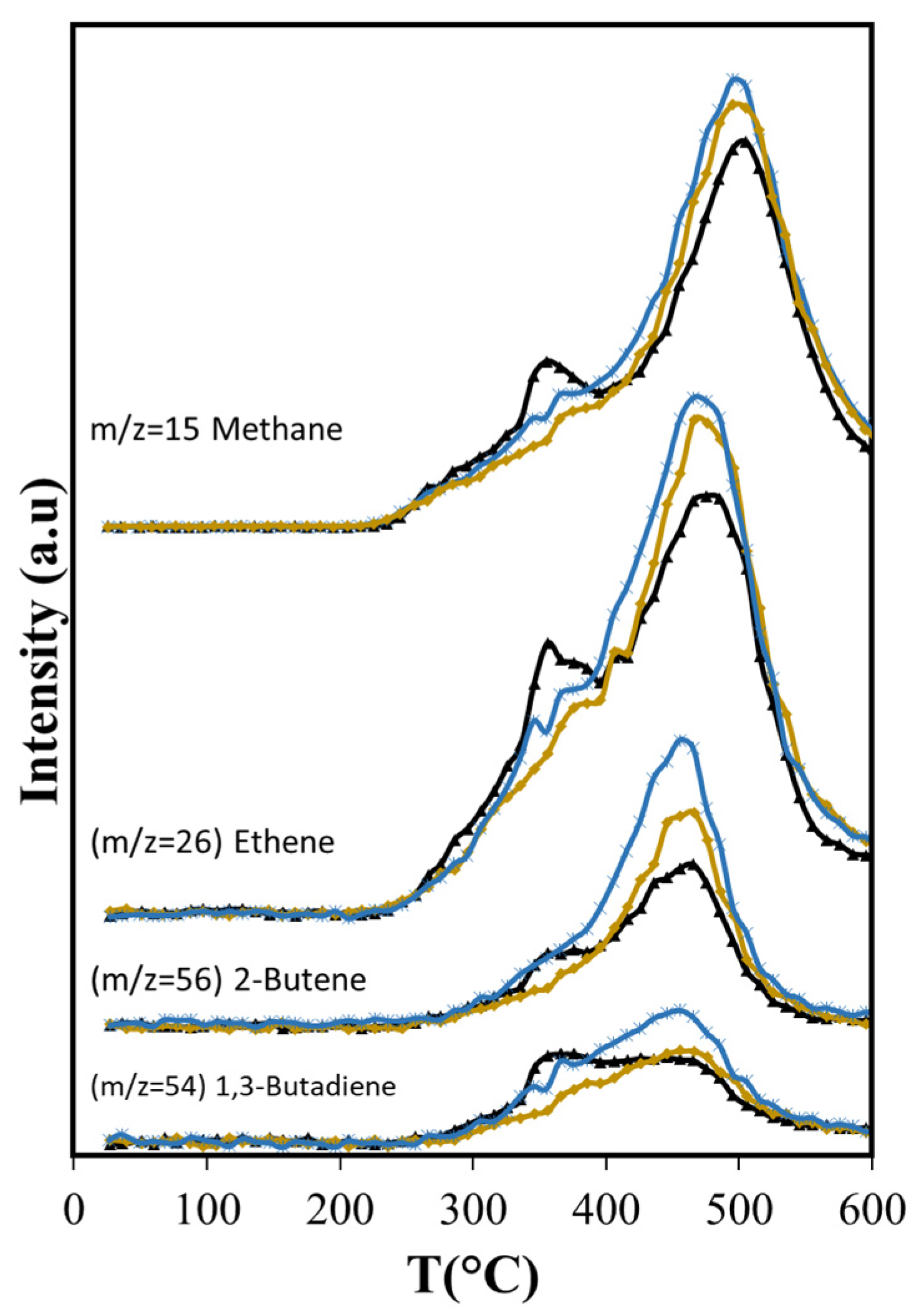
 ASB,
ASB,  Aerosil 380,
Aerosil 380,  MCM-41).
MCM-41).
 ASB,
ASB,  Aerosil 380,
Aerosil 380,  MCM-41).
MCM-41).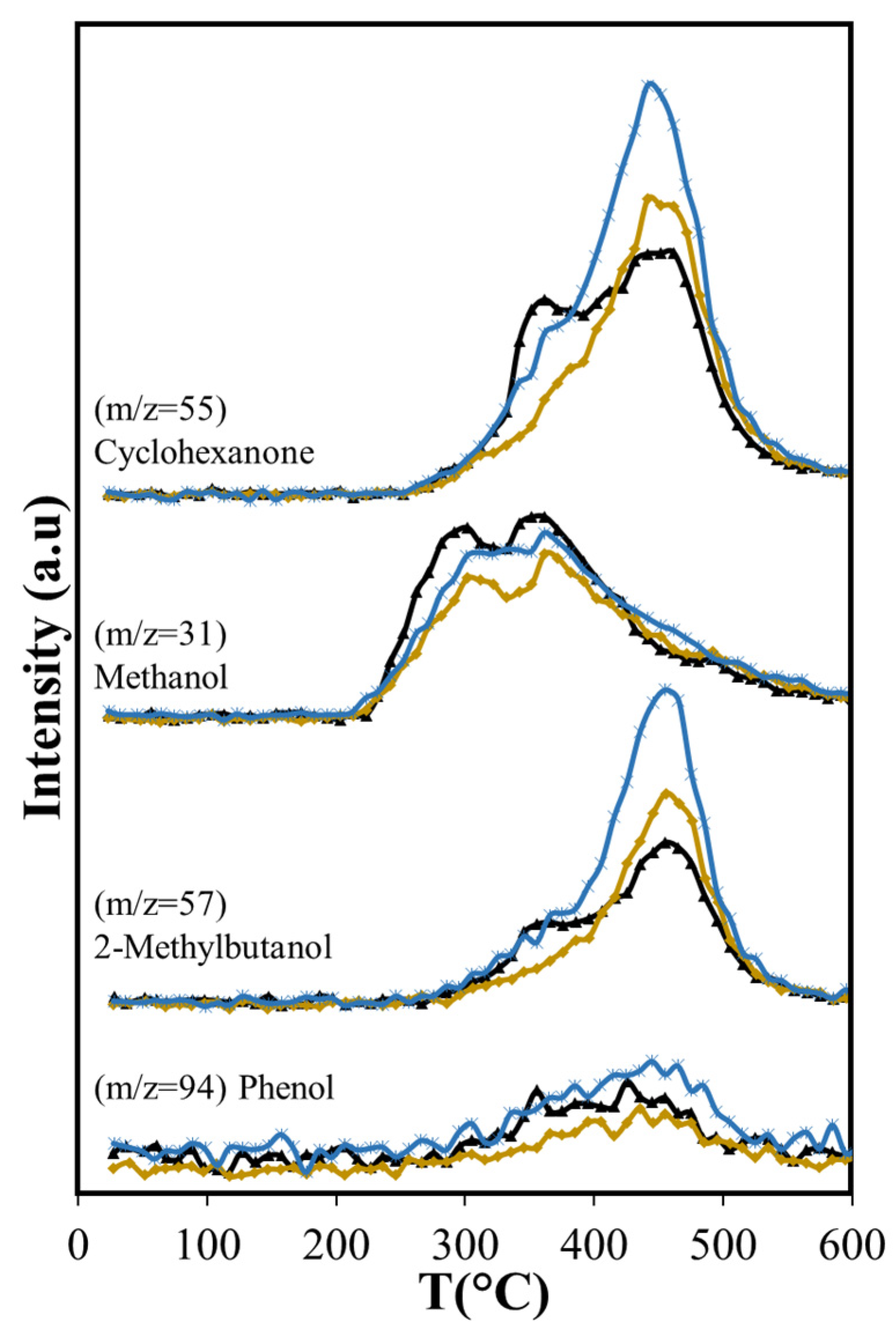
 ASB,
ASB,  Aerosil 380,
Aerosil 380,  MCM-41).
MCM-41).
 ASB,
ASB,  Aerosil 380,
Aerosil 380,  MCM-41).
MCM-41).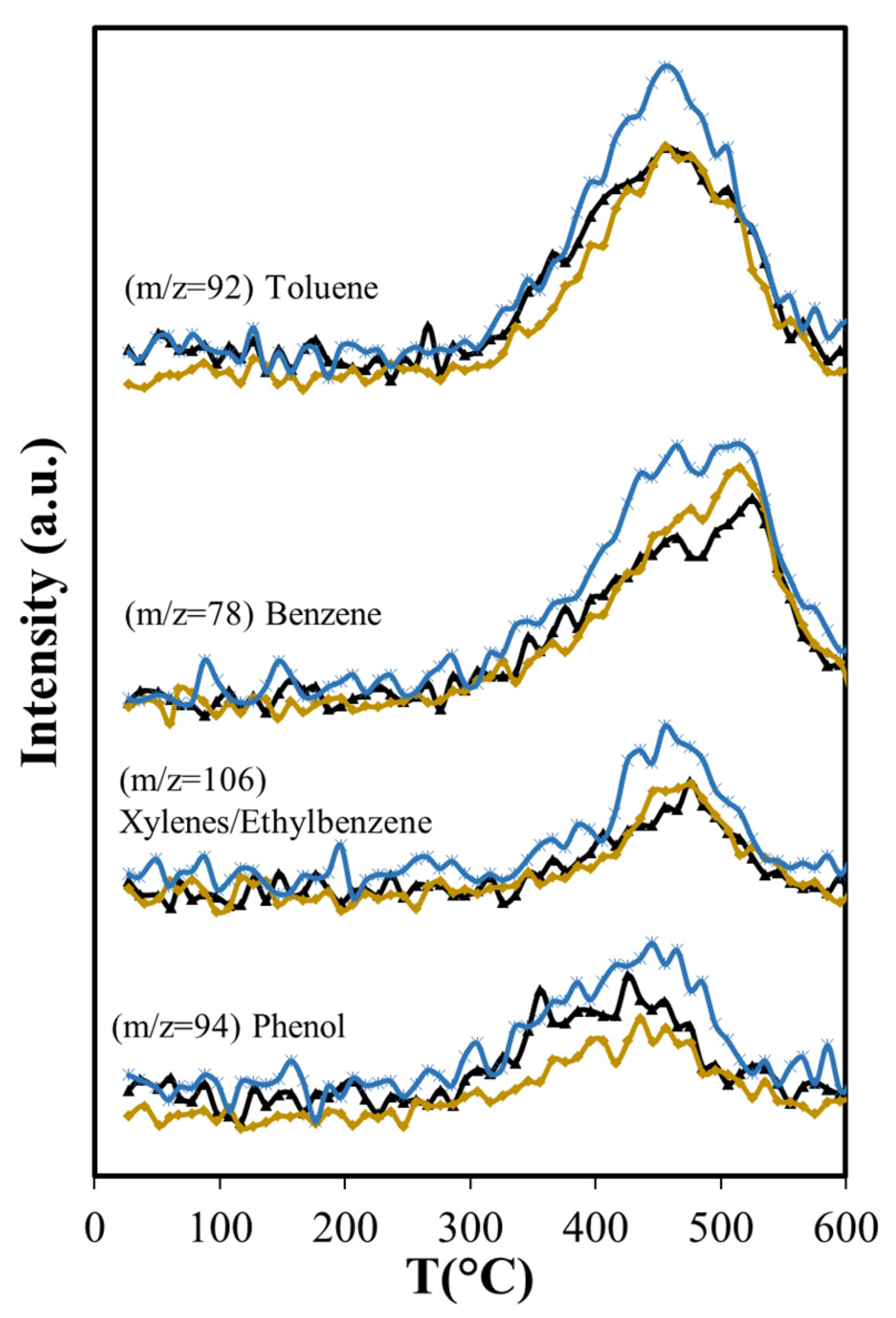
 ASB,
ASB,  Aerosil 380,
Aerosil 380,  MCM-41).
MCM-41).
 ASB,
ASB,  Aerosil 380,
Aerosil 380,  MCM-41).
MCM-41).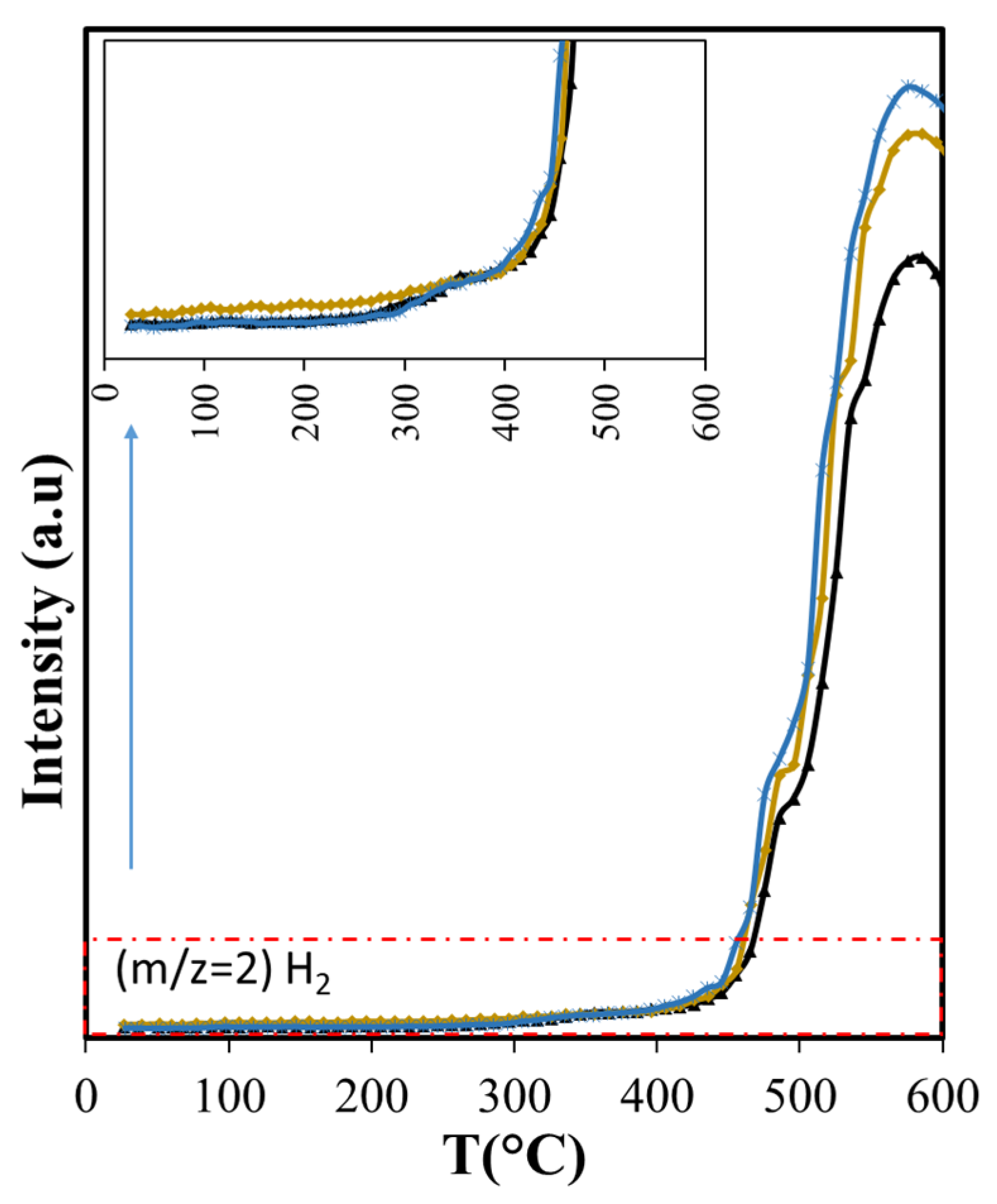
| Catalyst | BET Surface Area (m2/g) | Pore Diameter (nm) | Mesopore Total Volume (cm3/g) |
|---|---|---|---|
| MCM-41 | 1290 | 3.4 | 0.91 |
| wt% | |
|---|---|
| Moisture | 5.7 |
| Total solids | 94.3 |
| Ash | 2.2 |
| wt% | |
|---|---|
| Extractives | 3.6 |
| Acid insoluble lignin | 9.9 |
| Glucose | 66.5 |
| Xylose | 20.0 |
| Total | 100 |
| Compound | Formula | O/C Ratio | Tbp, °C |
|---|---|---|---|
| Bio-gas components | |||
| Hydrogen | H2 | - | −252.9 |
| Carbon monoxide | CO | 1 | −191.5 |
| Methane | CH4 | 0 | −161.6 |
| Ethene | C2H4 | 0 | −103.7 |
| Ethane | C2H6 | 0 | −89 |
| Carbon dioxide | CO2 | 2 | −78.5 |
| 1,3-Butadiene | C4H6 | 0 | −4.4 |
| 2-Butene | C4H8 | 0 | 1 |
| Furan | C4H4O | 1/4 | 31 |
| Pentane | C5H12 | 0 | 36.1 |
| Cyclopentadiene | C5H6 | 0 | 40.8 |
| Bio-oil components | |||
| Propanone | C3H6O | 1/3 | 56 |
| 2-Methylfuran | C5H6O | 1/5 | 63 |
| Methanol | CH3OH | 1 | 65 |
| Benzene | C6H6 | 0 | 80 |
| Water | H2O | - | 100 |
| 2-Pentanone | C5H10O | 1/5 | 101 |
| Toluene | C7H8 | 0 | 111 |
| Acetic acid | CH3COOH | 1 | 118 |
| 2-Methylbutanol | C5H12O | 1/5 | 129 |
| Xylenes (o, m, p)/Ethylbenzene | C8H10 | 0 | 136–144 |
| Cyclohexanone | C6H10O | 1/6 | 155 |
| Furfural | C5H4O2 | 2/5 | 162 |
| Furanmethanol | C5H6O2 | 2/5 | 170 |
| Phenol | C6H6O | 1/6 | 182 |
| 5-Methylfurfural | C6H6O2 | 1/3 | 187 |
| Benzyl alcohol | C7H8O | 1/7 | 205 |
| 2(5H)-Furanone | C4H4O2 | 1/2 | 212 |
| Compound | Aerosil-380, % | MCM-41, % |
|---|---|---|
| Acetic acid | −50.7 | −22.1 |
| Methanol | −16.9 | −2.9 |
| 2(5H)-Furanone | −32.9 | −0.4 |
| CO2 | 1.4 | 3.5 |
| Ethene | 2.5 | 8.9 |
| Methane | 1.9 | 10.4 |
| 1,3-Butadiene | −14.2 | 15.6 |
| Furfural | −13.8 | 16.6 |
| Toluene | −1.0 | 17.3 |
| Benzene | 8.4 | 19.6 |
| Furan | −16.9 | 23.7 |
| Phenol | −6.8 | 27.3 |
| Xylenes/Ethylbenzene | −2.2 | 27.4 |
| H2 | 10.1 | 28.7 |
| Cyclohexanone | −15.9 | 37.9 |
| 2-Methylfuran | −4.6 | 40.4 |
| 2-Methylbutanol | −2.0 | 42.5 |
| 2-butene | 6.3 | 44.6 |
Disclaimer/Publisher’s Note: The statements, opinions and data contained in all publications are solely those of the individual author(s) and contributor(s) and not of MDPI and/or the editor(s). MDPI and/or the editor(s) disclaim responsibility for any injury to people or property resulting from any ideas, methods, instructions or products referred to in the content. |
© 2023 by the authors. Licensee MDPI, Basel, Switzerland. This article is an open access article distributed under the terms and conditions of the Creative Commons Attribution (CC BY) license (https://creativecommons.org/licenses/by/4.0/).
Share and Cite
Santiago-Martínez, L.; González-Falcón, C.I.; Reyes-Hernández, J.; Handy, B.E.; Cárdenas-Galindo, M.-G. Improved Light Hydrocarbon, Furans, and BTEX Production from the Catalytic Assisted Pyrolysis of Agave salmiana Bagasse over Silica Mesoporous Catalysts. Catalysts 2023, 13, 548. https://doi.org/10.3390/catal13030548
Santiago-Martínez L, González-Falcón CI, Reyes-Hernández J, Handy BE, Cárdenas-Galindo M-G. Improved Light Hydrocarbon, Furans, and BTEX Production from the Catalytic Assisted Pyrolysis of Agave salmiana Bagasse over Silica Mesoporous Catalysts. Catalysts. 2023; 13(3):548. https://doi.org/10.3390/catal13030548
Chicago/Turabian StyleSantiago-Martínez, Leoncio, César Irán González-Falcón, Jaime Reyes-Hernández, Brent E. Handy, and María-Guadalupe Cárdenas-Galindo. 2023. "Improved Light Hydrocarbon, Furans, and BTEX Production from the Catalytic Assisted Pyrolysis of Agave salmiana Bagasse over Silica Mesoporous Catalysts" Catalysts 13, no. 3: 548. https://doi.org/10.3390/catal13030548
APA StyleSantiago-Martínez, L., González-Falcón, C. I., Reyes-Hernández, J., Handy, B. E., & Cárdenas-Galindo, M.-G. (2023). Improved Light Hydrocarbon, Furans, and BTEX Production from the Catalytic Assisted Pyrolysis of Agave salmiana Bagasse over Silica Mesoporous Catalysts. Catalysts, 13(3), 548. https://doi.org/10.3390/catal13030548








